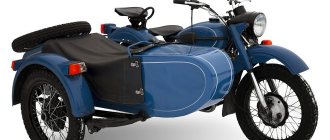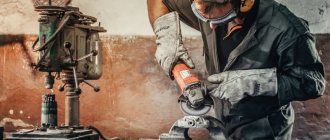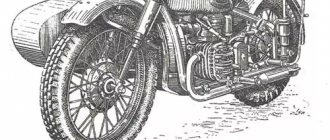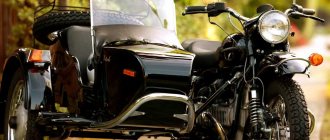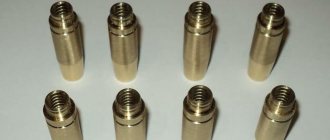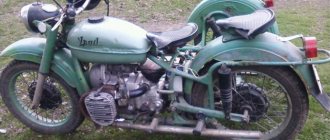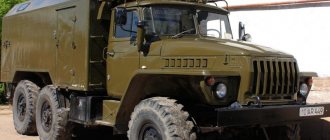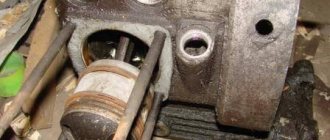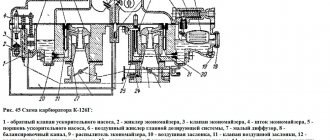What owner of a domestic motorcycle has not thought about tuning the engine of a Ural motorcycle? This burning question worries many fans of domestic Ural motorcycles! The fact is that the standard Ural engine has many manufacturing inaccuracies and is technically imperfect. Depending on the model and year of manufacture, the power of the Ural motorcycle varies from 32 to 36 horsepower, which in our time is considered low for an engine capacity of 650 cubic centimeters. In this article we will look at how to increase the power of a stock outdated engine. I would like to note right away that a lot of turning work will be required; find a workshop in advance that will agree to help you in this matter.
The Ural boxer engine has great potential for tuning, thanks to a piston diameter of 78mm and a stroke of 68mm. With this configuration, the engine could be revving, unfortunately the quality of the parts and the purpose of the motorcycle do not allow this to happen. In the article we will look at the solution to this problem, due to which you can achieve impressive results from the operation of such an engine, namely:
- Engine head tuning
- Camshaft tuning
- Cylinders and pistons
- Carburetors and ignition
- Additional engine modifications
Engine head tuning
Through the channels of the engine heads, the cylinders are filled with a fuel mixture, and exhaust gases are released. The more efficiently the cylinders are filled and the exhaust gases escape more easily, the greater the engine power. To tune the Ural engine heads, you will need to remove the valves. The diameter of the original Ural valves is only 38mm inlet and 35mm exhaust, which affects the suffocation of the engine. Along with the valves, you need to press out the old valve seats and guides. The seats for the saddles should be bored to the size of the Dnieper saddles. New enlarged seats will allow the installation of larger diameter valves 40mm inlet and 38mm exhaust from the Dnieper. The best alternative to Dnepr valves would be valves from Audi. The quality of automobile spare parts is much higher, and thanks to the fixation with new type of crackers, the service life of the heads can be significantly increased. We recommend using bronze valve guides from VAZ 2101-2107.
Internal grooves improve lubrication of the valve stem. The movement of valves in them is the most efficient with minimal friction losses, and the service life is much longer. Bronze perfectly removes heat from the valve, which will have a positive effect on the stability of valve clearances.
It is important to know: when choosing valves, do not run into a fake. Exhaust valves made of heat-resistant steel should not be magnetized. Bronze guides are also not magnetic.
Please note that the gap between the guide and the valve stem is required from 0.04 to 0.06 mm. The valve should move freely in the bushing without dangling in it. By the way, we would like to note that the car guides have a seat for the oil seal. We strongly do not recommend installing it, since lubrication occurs by splashing oil, and not under pressure as in cars. After installing new valve guides, pay attention to the trimming of the valve seats. It is necessary to trim the seat along three chamfers: 60, 30 and 45 degrees, of which 45 degrees is the working one, which comes into contact with the valve plate, ensuring a tight fit. You will also have to replace the standard valve springs with automotive ones from the VAZ 2108. They are somewhat stiffer than the original ones, and are able to ensure smooth operation of the valves at high speeds. But keep in mind that with such springs, the camshaft is subject to accelerated wear - tuning a motorcycle engine requires sacrifice. The final procedure for tuning the heads is to bore the intake and exhaust channels with a cutter a couple of millimeters larger in diameter. At the same time, it will be possible to get rid of casting sagging and ensure better engine breathing. The exhaust channel should be polished to a mirror, and the intake channel should be left matte, slightly rough, to prevent fuel condensation on the walls. After tuning the heads, do not forget to blow out all the channels and hard-to-reach places with compressed air, and grind in the new valves. Grinding must be done manually using a two-component lapping paste. Never use a drill. A hose is put into tension on the opposite end of the valve stem, thus rotating the valve with your palms until you get a matte ring on the seat and valve plate with a thickness of 1.2-1.6 mm. Check the tightness of the valve by pouring keratin into the channels for 1-2 minutes.
Liquid cooling Ural 650
KBMTS has more than 10 options for liquid cooling of the Ural 650 engine. Almost all of them are quite expensive, or for special purposes.
Now I'm making another attempt to create affordable liquid cooling. Affordable not only in terms of cost, but also affordable in terms of the ability to make it for the oppositionist himself. A variation of the Liquid Cooling System “LLC” will be offered, but with a single technical solution “cylinder-head”. The previous “cylinder-head” set almost completely solved the problem of stabilizing the temperature regime, but turned out to be ruinous for KBMTS. Many other options for simplified liquid cooling gave rise to problems of configuration or assembly, and unreliable condition of individual parts.
* la, sho - again? This time a bucket under the pot?
I would change the name for a start. Whatever you name the yacht, that’s how it will sail. LSS is never an option.
I’ll duplicate the photo, where you can see that the outer perimeter of the head is washed with liquid to a depth of 8mm to 40mm. This turned out to be quite enough for the head. The last USSR championship was won on these heads, when they raced on boxers.
*looks at the photo and cries*
The search for the simplest and cheapest option led to this “temperature ring”.
And it worked quite well on the engine installed on the “Locomotive” attraction, even in the heat with a quiet engine operating mode. But on the Irbit ST motorcycle the ring was clearly not enough: constant or intermittent boiling. True, the “temperature ring” was immediately planned only for water. Compared to an engine without cooling, the advantages were clear, but the Irbit ST had a thermosyphon cooling system.
The cheapness of the ring required the preparation of the cylinder ribs.
And still, after a couple of months the ring began to leak. This was at the beginning of spring, when there was antifreeze in the system. The leakage of antifreeze itself is already a problem, but even under sudden loads the spitting of antifreeze through the expansion tank. The entire side of the boat was covered in antifreeze. However, the prospect of such a temperature ring operating only on water satisfied me, since we compared two motorcycles in the “moto-dachi” mode, the green one was with water, and the blue one was normal. And then the preparation of two motorcycles for a long run turned up. The Australians asked to prepare two “budget” motorcycles for the run: - Irbit, Kazakhstan, Altai, Mongolia, Ulan Ude and further to Magadan. So I put this ring on one of them.
oh yeaaah. I can’t help but remember the famous copper pipe. :)
And computer thermal paste
Blah, yesterday it was minus 22 outside, I was riding in a stroller in first or second gear, with amazing revs. annealed in short to the fullest. Even though it never overheated))))) casts a paradox, in the summer this Ural started up through the ass, and yesterday the engine, which was icy on the second kick, started.
I went to the garage on Saturday, and my whole motorcycle froze in such cold weather, the kick could barely move, I probably pumped it 20 times before it came to life, after the same number of attempts the motorcycle started up and wouldn’t go out.
umelec, it seems to me that it is impossible to find a compromise here.
Have you thought about an air/oil cooling kit?
You can't build a new barn from old boards! Dear umelec, you’re already a grown man, but you’re still in the same place. I think I already wrote somewhere that if you do a life support system, then the CPG must be done from scratch! If I had developed, based on the experience of my Japanese comrades, I would have made new cylinders with dropsy, new 3-valve heads, and two spark plugs per cylinder and, of course, a different piston. The point here is different, it can be done, how much it will cost. I wouldn’t put dropsy on my motorcycle even if they gave me a freebie kit. clean engine + everything assembled correctly + forged pistons and no problems.
It would be better to make some kind of simple (read inexpensive) oil pump with increased capacity, combined with the withdrawal of part of the oil into the radiator (via a pressure reducing valve, of course). And so that it is installed in its original place with a standard pan without interfering with the existing oil line. And people themselves will lay out the cooling line as they like, if they want, they’ll dump it in a sump, if they want, they’ll water the pistons. You can offer a pump + radiator set, you can add line components (steel tube with fittings, hoses, etc.). So that there is an offer for every wallet. This would be a real and purchasable kit kit. A week later on the forum someone raises the topic of oil cooling or piston watering.
to the point, I would buy such a pump. a regular one 300-400 rubles, for such a dalby up to 1500 and maybe more if it’s made of bodywork - is it an adequate price?
Camshaft tuning
This modification requires a very thoughtful approach; as a rule, a new cam shape is created experimentally and may not meet your expectations. A wide-phase camshaft will help to fully realize the capabilities of tuned cylinder heads. For moderate tuning, you can simply install it from the Ural model M 67-36. The photo below shows a wide-phase shaft on the left, and a regular one on the right.
If you want to achieve the maximum from the engine, then it is possible to increase the profile of the cams of the standard shaft. This can be done by welding the metal using argon welding. By increasing the width and height of the cams by a couple of millimeters, it is possible to achieve a shift in torque to the high speed region and increase power also by increasing the speed of the valve timing. Take into account the fact that such an engine will lose traction at low speeds and may even stall at idle. For this modification, we recommend finding a workshop or factory that can properly process the cam profile followed by carburizing. Then, it is important to make sure that the geometry of the shaft is even; there is a high probability that the shaft could be driven by a sharp temperature change; the curvature is checked with a dial indicator by an experienced turner.
Suspension tuning
Motorcyclists are not satisfied with the suspension, and they are thinking about what to replace the front fork with. One of my friends left his original fork, but replaced the springs with Izhevsk ones. The suspension became more comfortable, but comfort was not enough.
There is another option for upgrading the suspension, this is a fork from a Japanese motorcycle. The Japanese market is famous for its bikes. The first rather successful option, which will have to be digested a little, is the fork with the CBR 900 RR. This is a classic inverted fork that has proven itself very well.
If you decide to replace the fork, then take it with the wheel, brake discs and calipers, this will give you the opportunity to get rid of many problems in the future. But if your budget does not allow you to buy a Japanese part, then the Izhevsk fork with homemade traverses made of aluminum alloy should satisfy you.
Return to contents — ↑
Cylinders and pistons
One of the most important parts in an engine is the pistons. They take on a huge load from expanding gases and temperature. Low-quality standard pistons do not withstand loads well, often have different weights, and the piston rings cannot provide high compression due to their outdated design, this significantly affects the power, and the massiveness and number of rings make the piston very heavy, which prevents the engine from spinning. It is recommended to install forged pistons with imported rings. A good solution would be to install forged pistons from the Ural Wolf motorcycle; they have a convex surface, which will increase the compression ratio and significantly increase engine power.
As for the cylinders, it is preferable to replace them with aluminum ones with a cast iron liner. The thermal conductivity of aluminum is much higher, and effective heat dissipation is ensured. A significant improvement in cylinders is relining. The standard internal diameter of the cylinder liner is 78 mm, and if the volume of the standard engine of 650 cubic meters does not suit you, by replacing the original cylinder liners with liners from Moskvich 412 with an internal diameter of 82 mm, you can significantly increase the volume and, accordingly, power. Select the pistons accordingly for the new diameter.
To combat overheating, a cooling system in the form of installing an oil cooler and by forcefully spraying oil onto the bottoms of the pistons will be useful. To connect the oil cooler, an additional oil pump is needed, since the standard one is very weak. To pump oil through the radiator, it is advisable to install an oil pump from a Dnepr motorcycle. Drive the second pump through an adapter from the standard Ural pump. In order for the additional pump to fit in the crankcase, an enlarged sump is required, which will also have a positive effect on cooling. By slightly increasing the amount of oil in the system, it will be possible to distribute the thermal load, and the new aluminum pan will remove heat even better.
By connecting to the new oil pump an oil line made of a copper or steel capillary tube, which must first pass into the radiator, then cooled oil from it must flow to the inside of the pistons. To do this, the line from the radiator enters back into the crankcase and bifurcates so that the oil supply is directed to the bottom of the piston from the inside. An oil cooler can be purchased at a Japanese motorcycle dismantling shop, and an automatic transmission radiator of the size you need from any car is also perfect.
I'm a merman, I'm a merman. Work in the engine group should be calm, moderate and, and...i.i. I don’t know what it should be like, but I knew that I didn’t fall into its rhythm. The boss, Pushkarev, gave me the task of drawing all sorts of things, but not anything new. We both tormented each other: he wanted to give me a task that would make me hang on to him, or fall behind for a long time. And I tormented him with demands to give him a real job. So he lets me draw up the general view of the engine in three sheets plus technical specifications for the whole month. Having drawn everything in three days, I begin to hang out in the library, knowing that I have nothing more to give. This irritates other designers and Pushkarev too. They start disassembling: “Well, it’s impossible to draw the entire engine in three days, it’s impossible!” They give me something else and arrange for surveillance. Neighbor Tamara caught me using a draloscope - this is a glass table with a light bulb where a drawing copy is made. She started a scandal, started measuring the accuracy of my drawings, and everything turned out to be within the tolerance range. Why punish? And I had my own copying style, I still won’t say. Well, what should we do with it? - Pushkarev puzzled. Looks like I was needed to be sent to the assembly line when he missed the schedule. They sent young people, and only I was young. You come to the assembly line on the third shift, and the foreman usually says: “What, they sent you to work honestly?” This is why he’s mocking you, not only by sending you to the conveyor belt, they gave you a firm message that the department will cope without you, that you are ballast and so on. That's why I didn't get into the rhythm of the department's work.
However, the parts on the assembly line also ran out and we, the prefabricated teams, were released from the “front” in departments. The good thing about these links was that we became acquainted with all the capable technical intelligentsia of the entire plant. In total, about ten thousand people worked at the plant. And during one of the smoking breaks, the guys tortured me about engine overheating, about thermal conditions, and why I shouldn’t, for example, draw water cooling. It was practically with such a public task that I returned from the assembly line and pestered my boss. That one about - How can it not work? Is the Honda Golden Wing in the showroom? - This is Honda, they can do everything, but BMW doesn’t have a water one. - How about K-100? - Well, it’s in-line, but the opposite one doesn’t. - Well, let’s take the “Golden Wing” apart and have a look? - Yeah, just a minute! Now we’ll sort it all out for you, we’ll see everything. - Go to work, Viktor Nikolaevich, go. They sent me again, but the conversation was started. I found out that they actually painted the “water” in the department, it turned out to be very cumbersome and complex. They drew using parts from a VAZ or AZLK, probably for unification, or for ..... (so as not to do it ourselves). However, there are no drawings left, how come? Usually nothing is thrown away. Somehow, in the department’s archives, I found ideal tracing papers of the M-72 from the fifties for transfer to China. “Backup option,” the girls said. Or I somehow found thermal calculations of pistons of different geometries by designers from the 60s, I’ll tell you: “Very seriously.” But the calculations of the 80s were already similar to student diplomas. Talking a lot about old jobs with the “old people,” I was amazed at the workload of the department. The tasks they set, or were given, were colossal. Well-known names worked, but then they really left Irbit. There were many exiled Germans, evacuated Jews and crests. The design department had an interesting history and talented designers. I was sometimes compared to someone, and I was flattered. But the most important conclusion that I made from the analysis of the past: - Each subsequent generation of designers and technologists of the plant was an order of magnitude weaker than the previous one. (The word “weaker” is putting it mildly.) All this makes me sad. Pushkarev wanted to leave for a promotion, and he needed a replacement. But no one set their sights on his chair. At first, he seemed to be planning on me, but he didn’t like my eagerness to go into the clouds. I asked Vasily, the technologist from the engine shop, but he was either asking for money or solving the housing problem. In general, conversations with me about reasonableness began again. It was either my arguments that influenced Pushkarev, or his desire to “live in harmony,” or his disbelief in the “water” project, but I was given the task of designing a liquid-cooled engine. And I have it ready, but only in my brain. However, not everything is happy. They give me recommendations to follow analogues: there was something there, but there was a Volga-24, because Pushkarev had it, and he admired its engine. Well, yes, how can you disobey? “Drawing a GAZ-24,” or reading books. In the mid-80s, a lot of special technical literature was published. Entire institutes re-read the world's treasure troves and offered special editions for official use. I only had time to read abstract publications on small-capacity engines and motorcycles. And what interested me, I copied from Moscow to the library of the motor plant or just to read. And so, having read to the point of intoxication, and realizing that this was a crisis, I began to draw something. Well, like the whole engine in three days. But after this the real construction begins. I won’t tell everyone about my creative torments and triumphs, but after a month everything was ready. Pushkarev walked up to the drawing board and looked at it with an arrogant sneer. - Why is your fitting so thin, so beautiful? “There’s not a lot of space on the head, so I drew it more carefully.” — Have you seen what kind of Volga GAZ-24 they are? Threaded, and everything stands perfectly. - But with a threaded one it will be cumbersome? - But it’s reliable. - Vladimir Afanasyevich, the heads are already terribly swollen, and you will also need a body for threading. No one does the same anymore. - I’m telling you, they’re on the Volga. — Let’s go to the showroom and look at the analogues. We've arrived. Pushkarev fell into the tenacious clutches of Zefirov, who was happy to share the latest news. But I fell in love with the boxer Honda “Golden Wing” and, under the guise of a similar release of coolant from the head, I justified my choice. — Let's see how the Honda's output tube is pressed in. - Boris Vladimirovich, take off the young man’s right head, he wants to learn from the Japanese. - Good job, good, do you know what the Japanese did? They managed to make an oval piston and cylinder, Victor showed it to me. Pushkarev was already apparently wedged from the attention of a special veteran, and the oval piston almost finished him off; ready for anything, he pointed to the Golden Wing. To an untouchable motorcycle, to a motorcycle of unimaginable technology, and so on. We left. The head was apparently removed with the thrill of lifting the “iron curtain”, because when I returned, Boris Vladimirovich, betraying his image, only remained silent and showed only with his hands. Indeed, the coolant exited the head through an aluminum tube with a wall thickness of less than one millimeter, and the seal was a rubber ring with a cross-section of two millimeters. To prevent damage to the outside of the tube, it is covered with a protective steel spring. All! When I brought this Japanese “macrame” to the boss’s table, he didn’t think about anything at all. -What did you bring? — Here is the water outlet fitting from the head in the form of a thin-walled aluminum tube and an O-ring to prevent a coolant breakthrough. All! I don’t know about Pushkarev, but I had a design shock. How easy and beautiful a solution can be proposed. Pushkarev no longer argued with me, my colleagues didn’t interfere too much, they took the entire folder of drawings down to the experimental workshop. That's all. Then my energy stopped working. No one was in a hurry to complete the project: the authorities have a lot to do to deal with the “water”, Zavyalov has no opportunity at all to rush the production, and who else? Everyone is working, why bother? Everything sort of fell through for six months, but then they got it going, apparently the workshop had absolutely nothing to do. And immediately hanging: “We can’t cast this, but how will we control these dimensions? But as …? Where can I get you...? But by this time Pushkarev had become deputy chief, putting me, to his great regret, in my place (he’ll eat me up later, but that’s later). Having become the head of the engine group, I was surprised to discover that the opportunities to create, to create something, were not only less, but completely gone. I had to work: go to two or three meetings a day. I began to answer the papers that were indecently accumulating on my desk. It was necessary to prepare answers for the authorities to the papers marked “urgent” that were lying on their desks. There were a hundred times more business trips: - I was young, how could I get out. Sometimes the boss would push me into such nonsense (for example, to a scientific seminar on vibration theory), in which not only did I not understand anything about what was being done, but those present only came to an understanding in the evening after a Finnish sauna and a decent dose of special fluid. No matter how we did a lot of important work there, sometimes a “water bug” popped up, and I changed something, moved something, but almost more than six months later the workshop began assembling three copies of the engines. And six months later, after jerking the liquid-cooled engine on the stand, it was placed on a cargo rack that ensured the operation of the road test laboratory. This is to bring fuel and lubricants, remove garbage, deliver equipment to the test site. It’s not that I lost interest in the project, I was overwhelmed by routine. I also have a social, youth, but motorcycle project. I developed an interest in invention, in a whole new level of new projects. True, it got to the point of a scandal that the chief engineer forbade me to engage in inventions not related to my official assignment. But I’ll tell you this separately, but meanwhile an unusual incident happened to the “mer.”
Summer, hot. But I was on vacation with my mother-in-law in Ukraine and was not in the know. Everything happened without me. The testers stole three control and sample motorcycles and two experimental ones for road tests: speed, noise, consumption. Control-sample: - these are motorcycles removed from the assembly line by state acceptance, which were supposed to show the indicators declared by the plant, for example, a speed of 105 km per hour. Experimental ones were used for the same purpose, but they have more risks and experienced nodes. They also took a “shmonka” with my “water”, for equipment and all sorts of junk. Road tests were carried out on a regular one-kilometer section of asphalt road with general traffic blocked. The plant did not have a landfill. We arrived, set up the Omega devices, and they also needed to be tested. They let in the control-selective one first: the speed is 95, and now there will be a sticking. Heat - 36 in the shade. What to do? They began to wait for at least a cloud. Everyone is sitting and waiting. - Well, why wait, let’s at least set up the devices. — What should you drive to tune it? All motorcycles are valid. - Let's launch the "shmonka." — There is also an experimental liquid there. When we finish, we'll get hit on the head from the boss. - So we’ll test the “water one.” The head of the road, Vladislav, takes responsibility and the “shmonka” is launched for a kilometer straight away. That is, you need to enter at the beginning of the kilometer at maximum speed and exit at maximum speed, record the entry and exit, and then calculate the average speed. Go. Everything seems fine. — What is the maximum speed there? - Let's count again... One hundred and twelve! -How many? What did you count there? — One hundred and twelve kilometers per hour. -It can’t be like that. Run in the opposite direction. According to the rules, the motorcycle being tested had to pass the test in one direction and the other way, then the average speed was calculated, and so it was considered valid. Recently, with the stroller, they somehow pulled it up to 105, and even then with special settings. So I went in reverse at maximum speed. - How many are there, accountants? - One hundred thirteen and five tenths. - What are you talking about? What if you twist the carburetors? — Let’s add some gasoline from the measuring flask and we’ll estimate the consumption. The arsenal also included a gasoline flow meter with a control line. It was placed in the sidecar of a motorcycle and was hooked up to the carburetors with hoses. I don’t know the details of how the TV stroller tester turned it on and off, but in fact they measure it quite accurately. And roughly the consumption was measured by adding it to the gas tank from a measuring flask. - Let's launch it first. - One hundred and twelve! - Yes, oh... oh, oh. Look at the flow rate or let it go to the “return”, then top it up. - One hundred and fourteen! Almost. - Yes oh...it,...it. What about the expense? What do you think there? - About twelve! 12 per 100 km, with a maximum speed of 112.5 km per hour. - Super! This is a bomb! Then they somehow started riding other motorcycles. It's hot, results? - rubbish. But everyone was impressed by the “water” races. Much time has passed, the authorities have lost fighters. Deputy Chief Khalturin arrived. - Why did it take so long? Why are you bothering? - Listen, Anatoly Vasilyevich, we have a sensation here. -What have you done? The deputy chief did not expect anything positive from the testers. I always suspected something untoward and expected some kind of dirty trick. - Here, not a single motorcycle can give indicators - it’s hot, but the “shmonka” showed one hundred and fourteen. - What kind of "shmonka"? What are one hundred and fourteen? - Yes, here is a cargo vehicle. - Technician one hundred and fourteen, but not a single motorcycle is moving? Is this an excuse? They have a sensation here. - Yes, and the cost is only twelve! - Listen, who are you talking to? Yes, I have gone through more such tests than you all combined. Well, start your “shmonka”. We ran it back and forth, the results were the same: one hundred and thirteen and the expense was twelve and a few kopecks. Consumption at maximum speed has never been officially announced. At a speed of one hundred and five kilometers per hour, it was more than 17 liters per hundred kilometers, this is on a regular motorcycle with two passengers and cargo in the sidecar. It was horror, but quiet horror. Officially, consumption was measured at seventy kilometers per hour, and it was seven to eight liters per hundred kilometers. But further, with increasing speed, the consumption increased exponentially. In fact, gasoline was used to cool the pistons and cylinders and then burned in the mufflers. The water one saved almost a third of fuel: a stunning effect. But the figure is for official use only. I arrived about two weeks later and was greeted with delight by the testers. However, neither the management nor the designer showed any enthusiasm or annoyance. Everyone shared memories of how the harbor with a huge supply of timber burned. And the spectacle was truly grandiose and terrible. But the testers gave me the nickname “Waterman”. Six months later, when I was on a business trip, I was promoted from manager to designer. Pushkarev installed the faithful Vasily. Upon my return, I was stunned and offended, but within a month I appreciated the possibilities of much greater freedom and became interested in the project of a new vehicle and the creation of a youth creative team - MTK. But that's another story. A couple of years later, the management remembered the “water guy”. The second engine went through testing, and Tamara, my former neighbor on the drawing board, was given the opportunity to develop an option for pre-production. I then worked in the advanced design group and only occasionally dropped in to look at Tamara’s work. Maybe I was jealous of the changes to my design, but the project was deteriorating with each passing week. Maybe this is the participation of factory technologists, but some decisions began to remind me of Volga-24. And although many of my decisions returned to the “water” version after road tests, I officially refused authorship of the model that went into small series. Spring, 1991. Yes, it was real spring. We are Zavyalov, Borisikhin and the company; we are opening our own private enterprise, the Kamandit Partnership KBMTS. The first significant project of the Design Bureau was the KBMTS-07 liquid cooling engine and the W-650-7 liquid cooling kit. More than 50 engines and 70 kits were produced. The first batch of engines went to the DOSAAF society for cross-country motorcycles with sidecars. But the project for the new “water” was not born on the opening day of KBMTS. The project has been developed underground since 1989. And in 1991, at the last USSR championship, the crew of Mikhail Tyulenev and Leonid Kursov won the title of champions in our “water”. Active participants in the project were mechanic Nikolai Pakhomov, tester Alexander Mordyashov, casting technologist Andrei Gubin, and KBMTS comrades.
For five to seven years this project fed us until all production collapsed in the country. The water guy went to sports, mini tractors, motorcycle rides, and so on. However, the motorcycle plant did not forget us. My dearly beloved Pushkarev informed the management that KBMTS was rushing everything from the factory and making hacky “water” ones in the basement. Chief engineer Perminov with the security service. They checked the foundry, the sales department, and individual workshops for theft of the factory water supply. But it turned out that the foundry and others provided legal services for the manufacture of KBMTS parts according to the drawings and equipment of the design bureau. There were several more slander, they frayed my nerves! True, at the peasant level they worked fine. One day a technologist from the experimental laboratory arrived and laid out all the troubles of mastering water technology on the table. And there were the mistakes of a first-grader, either Pushkarev fanned the design with the halo of a “Volga GAZ-24”, or “pre-production” mocked the designers. Well, how can I not help, if they helped me more than once, then the guys managed and a small batch was produced by the plant. But after the Hercules tricycle was discontinued from production, the water one also disappeared. And KBMTS floundered with the waterman for a long time. But without certain technologies that were available only on the territory of the Motor Plant, it was difficult for us to continue production. Then there were several attempts to reduce the cost of producing liquid cooling kits. The main problem that does not allow us to restore the previous “water” design is the impossibility of restoring the foundry technology at our equipment, but at other enterprises (it turned out great). Briefly speaking? – we can’t cast heads, but we can do the rest. Now, if I can separate the cutlet from the side dish and the fly, then everything can happen again.
Carburetors and ignition
Tuning a Ural motorcycle engine affects all engine systems, including ignition and carburetors. It is recommended to read the information: how to properly configure Ural carburetors. The standard ignition is so outdated that it is not even suitable for everyday driving, let alone anything else. It is desirable to install a microprocessor ignition with the possibility of an automatic advance angle. This article will help you set up the electronic ignition system. Ideally, such an ignition would be installed with a programmable controller with the ability to adjust the firmware. Such ignition systems have another useful feature - speed cut-off. This will prevent over-torque of a heavily boosted engine. Well, for maximum spark strength, in combination with a new ignition, you can use a coil from the Oka or Gazelle. Branded high-voltage wires with silicone insulation and internal resistance are required, for example from Tesla from VAZ 2108. They will ensure an uninterrupted spark in any weather and eliminate the possibility of spark breakdown to ground. As for carburetors, you will need to install Japanese vacuum carburetors with a diffuser diameter of 32 to 36 mm, followed by selection of jets, synchronization and adjustment with a gas analyzer. Tuning on a dynamometer is highly advisable, where you can test different settings and ignition timing and get the most out of your motorcycle tuning!
Motorcycle Ural tuning
Many people want to stand out from the crowd with their vehicles. You can make an excellent chopper from the Urals, and in general the Ural motorcycle is a good option for tuning. Recently, you can increasingly see tuned motorcycles on the street. Choppers came to us from America. And if you are planning to make a chopper from your Urals, then you should listen to the materials that are located further.
The first thing to start with is the wings. According to many bikers, they should not be in a chopper. Next we will talk about the tank. Here they listen to the expression, the less the better, but this does not mean that the tank should have a volume of two liters, everything should be in moderation. The seat was only for the driver, because the bikers rode alone.
Return to contents — ↑
Additional engine modifications
In addition to the above methods of tuning a Ural motorcycle, there are several more secrets. It is possible to install a crankshaft from the K 750 on the Ural engine, which will increase the cylinder stroke to 78mm.
Thus, it is possible to significantly increase the working volume of the Ural engine. It's quite difficult to find, but it's worth it. Another problem with the motorcycle is the tight response to the throttle and slow acceleration. The reason for this is that the flywheel is too heavy, the weight of which is designed for riding with a stroller and for transporting heavy objects.
According to the drawing, it is possible to reduce its weight by a couple of kilograms. Due to the weight reduction, the inertia of the crankshaft will decrease, and the acceleration dynamics will significantly increase. To fully realize the power on the road, the gears of the gearbox must be replaced with 9 or 10 pairs. In conclusion, we would like to note that tuning the Ural motorcycle engine is justified only for racing purposes; for everyday use, such an engine will have a short resource and significant fuel consumption.
I did water cooling
I made water cooling like the car, it doesn’t look very good, but the engine is now a bomb
bomb? tends to explode?
radiator stove from a Muscovite - fan - pump homemade - drive from a generator heads welded liners wet cylinders reduced by 2.5 mm compression 10-11 atm gasoline A 80 power increased in any heat and does not usually boil under any load 80 85 t engine life increased by Noise has decreased several times, I've been driving for 8 years
And I installed a proton engine with an accelerator synchrophasotron in my Urals. Acceleration in 1 second to Mach 16. It really eats a lot, you have to carry a 40 liter canister with protons with you.
I tried it, they didn’t want to go into the oven, they resisted.
Someone opened the registration - the kids have arrived! FAT trolling, I wish I had a photo!
By the way, dropsy of one not unknown now banned opposition member
This banned opposition man also promised me a lathe, once upon a time
